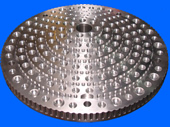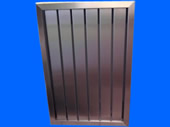Stainless Steel Fabrication
Stainless steel can compete with higher cost engineering metals and alloys based on nickel or titanium, whilst offering a range of corrosion resisting properties suitable for a wide range of applications.
Stainless steel can be manipulated and fabricated using a wide range of engineering techniques and are fully "recyclable" at the end of their useful life.
Stainless steels are corrosion resistant alloys their life expectancy is usually long. A minimum of maintenance is needed and so, although more expensive initially, they offer attractive "life-cycle cost" benefits over alternatives such as carbon steels.



As an easy to clean metal, Stainless Steel is an obvious choice for the catering, food and beverage manufacturing industries. There are no proven health risks from the normal use of stainless steels. The possible risks from alloying elements such as nickel and chromium are under constant review by experts.
Stainless steel offers many advantages to the construction/food and pharmaceutical metal user. The main advantages include its:
| high corrosion resistance, allowing it to be used in rigorous environments. | |
| fire and heat resistance allowing it to resist scaling and retain strength at high temperatures. | |
| Hygienic, non-porous, surface coupled with the easy cleaning ability of stainless makes it the primary choice for applications that require strict hygiene control, such as hospitals, kitchens, and other food processing plants. | |
| aesthetic appearance, providing a modern and attractive appearance for most architectural metal applications. | |
| bright, and easily maintained surface making it an easy choice for applications demanding an attractive surface at all times. | |
| strength-to-weight advantage that allows it to be used with a reduced material thickness over conventional grades, often times generating cost savings. | |
| ease of fabrication due to the use of modern steel-making techniques that allow stainless steel to be cut, machined, fabricated, welded, and formed, as readily as traditional steels. | |
| resistance to impact even at extreme temperature variations. | |
| long-term value created by its long useful life cycle often yields the least expensive material option when compared to other metals. |